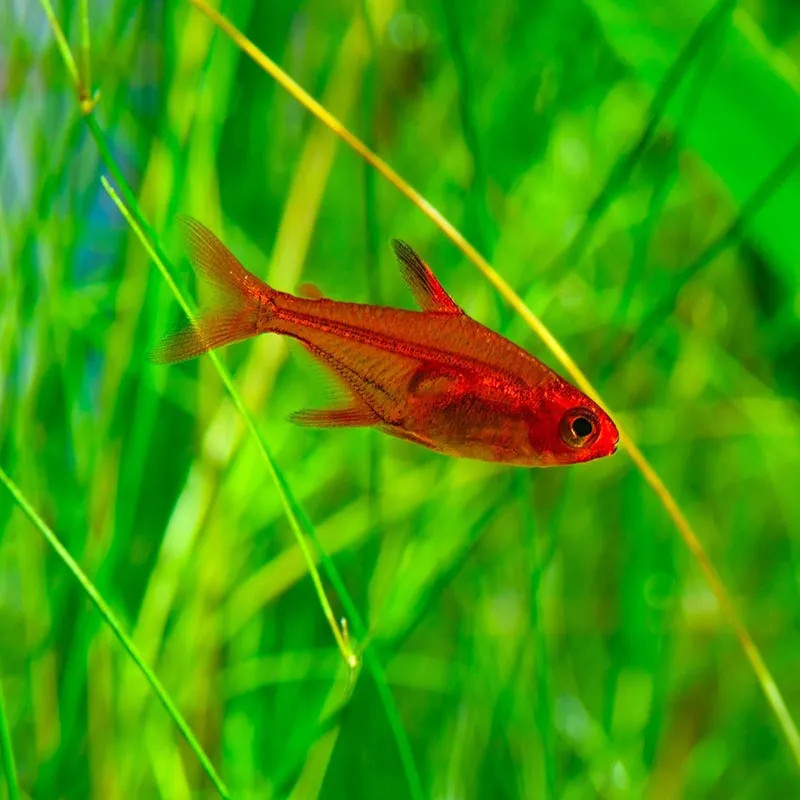Stocks Available
Neon Tetra
SKU:128165
PARACHEIRODON INNESI
0.5-1 INCH

Stock Available
Introduction: Species: Hyphessobrycon amandae Common Names: Ember Tetra, Amanda’s Tetra Natural Habitat: Native to the slow-moving, densely vegetated waters of the Araguaia River Basin in Brazil. They are found in calm, shallow waters with a rich presence of plant life. Physical Characteristics: Appearance: The Ember Tetra is known for its vibrant orange-red coloration, which stands out in any aquarium. Its small, slender, and translucent body adds a striking contrast against darker tank backgrounds or dense plant life. Their bright coloration intensifies when kept in healthy environments with good water quality. Size: Grows up to 0.8-1 inch (2-2.5 cm) in length. Lifespan: Typically 2-4 years in captivity with proper care. Habitat Requirements: Tank Size: A minimum of 10 gallons is recommended for a small school of 6 or more. These tiny tetras thrive in groups and are more active and less stressed when kept in larger schools. Water Conditions: Temperature: 72-82°F (22-28°C). pH: 5.5-7.0 (prefer slightly acidic water). Aquascaping: They thrive in well-planted aquariums with soft substrates and areas of subdued lighting. Floating plants or plants with broad leaves will help replicate their natural environment, creating shade and giving them hiding spots. Diet: Primary Diet: Omnivorous; in the wild, Ember Tetras feed on small invertebrates, microorganisms, and plant debris. Supplemental Feeding: In an aquarium, they do well with a diet of high-quality flakes or micro-pellets, supplemented with live or frozen foods like daphnia, brine shrimp, or micro-worms. Feeding Frequency: Feed small portions 1-2 times daily for optimal health. Compatibility: Temperament: Ember Tetras are peaceful, social fish that enjoy being in schools. They are ideal for nano tanks and community tanks with other small, non-aggressive species. Suitable Tank Mates: Good companions include other small, peaceful fish such as Neon Tetras, Pygmy Corydoras, Harlequin Rasboras, and small shrimp like Cherry Shrimp. Incompatibilities: Avoid aggressive or larger species that may prey on or stress them. Care Level: Difficulty: Easy; Ember Tetras are hardy and adaptable to various tank conditions, making them suitable for beginners and experienced aquarists alike. Health Monitoring: Regular water changes are crucial to keeping them healthy. Keep an eye on water quality, as they are more sensitive to sudden changes in water parameters. Breeding: Breeding in Captivity: Ember Tetras are relatively easy to breed in home aquariums. Provide a separate breeding tank with soft, acidic water and dense plants where females can scatter their eggs. Spawning: They are egg scatterers and do not provide parental care. To protect the eggs, it’s best to remove the adults after spawning. Economic Considerations: Market Demand: Due to their small size and striking color, Ember Tetras are popular among aquarists, especially those with nano aquariums. Wholesale/Retail Pricing: They are widely available and affordable, making them a popular choice for community tanks. Sustainability and Conservation: Wild Population: Not under significant threat, although habitat destruction in South America could impact their natural populations. Aquaculture Efforts: Commonly bred in captivity, reducing pressure on wild populations. Regulations: Ensure compliance with local and international trade regulations when buying or selling these fish. Conclusion: The Ember Tetra is a captivating addition to any aquarium with its glowing orange-red body and peaceful nature. Their small size and vibrant colors make them perfect for nano or planted tanks. With proper care, a stable environment, and a well-balanced diet, Ember Tetras will thrive and add beauty and liveliness to your aquarium.
Data sheet
16 other products in the same category:
Customers who bought this product also bought: